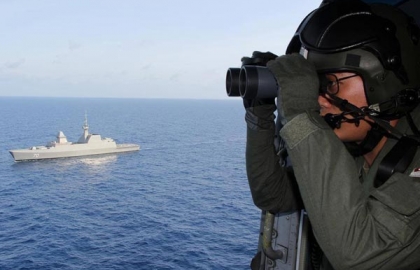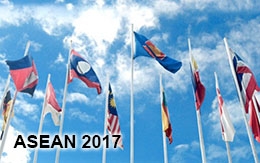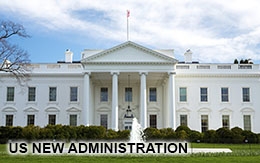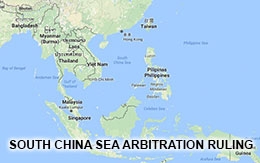Maritime Security in Southeast Asia - An Appraisal
As opposed to the definition of military security which relates to the security of a state and its people, maritime security covers a wider range to include maritime terrorism, people smuggling, narcotics trafficking, smuggling of goods, piracy, transnational crime, as well as environmental aspects such as illegal fishing, timber smuggling, and the smuggling of wildlife.
By Ab. Rahim Hussin, Jalila Abdul Jali, lMohamad Zulariff Abdullah
November 14, 2016

As opposed to the definition of military security which relates to the security of a state and its people, maritime security covers a wider range particularly after September 11 to include maritime terrorism, people smuggling, narcotics trafficking, smuggling of goods, piracy, transnational crime, as well as environmental aspects such as illegal fishing, timber smuggling, and the smuggling of wildlife.
Christian Bueger comments that “the ‘laundry list’ approach to defining maritime security has rightfully been criticized as insufficient since it does not prioritize issues, nor provide clues of how these issues are inter-linked, nor outlines how these threats can be addressed”.
Nevertheless, all nations have a responsibility for maintaining “good governance at sea” be it nationally, regionally or internationally. Lutz Feldt, Dr. Peter Roell and Ralph Thiele observe that the term “maritime security” is a responsibility, which has no clear definitions; it is a governmental responsibility, has no universal legal or agreed definition due to its broad topic”. Among the issues relating to maritime security are international and national peace and security; sovereignty, territorial integrity and political independence; security of sea lines of communications; security protection from crimes at sea; environmental issues and security of all seafarers and fishermen.
This paper provides an overview of maritime security in Southeast Asia and an appraisal of cooperative measures undertaken to combat armed robbery and piracy, incidents at sea, search and rescue, maritime domain awareness and information sharing.
Maritime security issues
Piracy and armed robbery - case study for Straits of Malacca
The seas of the Southeast Asian region are critical and important sea lanes of communication (SLOC) since they border the Pacific and Indian Ocean and are major arteries of communication and international commerce. The seas which cover about 80% of the region dominate the economic lifelines of the surrounding countries. Today more than half of the world’s annual merchant tonnages traverse Southeast Asian waters.
Piracy and armed robbery threats in this strategic SLOC has attracted much attention from states dependent on these water for international trade and free movement of goods. The best example of the effectiveness of regional cooperation in addressing maritime security threats in Southeast Asia is the Malacca Strait cooperation. The Strait of Malacca (SOM) is quite unique in that its shares borders with Indonesia, Malaysia and Singapore and connects three major oceans - the South China Sea, Indian Ocean and the Pacific Ocean.
Piracy and armed robberies in the Straits back in 2006 had resulted in Lloyd’s of London categorizing it as a “war risk zone” which among others resulted in higher insurance premiums for vessels using the straits. The littoral states of Indonesia, Malaysia and Singapore have taken very proactive moves to address this by establishing in July 2004, the Malacca Straits Security Initiative (MSSI). The current effort by the Malaysia, Indonesia, Singapore and Thailand is Malacca Strait Sea Patrol (MSSP) consists of surface and air surveillance a year-round operation to ensure greater safety of navigation in SOM. This includes the famous Eyes in the Sky or EIS, air patrol by using Maritime Patrol Aircraft (MPA) in the straits.
This cooperation is supported by the improvement of operations through continuous discussions among the three littoral states has led to a significant decline in seaborne crime, particularly maritime piracy and armed robbery in SOM. MSSP is also significant as being the effective multilateral cooperation in Southeast Asia without an extra-regional partner.
...
Click here for full text.
Christian Bueger comments that “the ‘laundry list’ approach to defining maritime security has rightfully been criticized as insufficient since it does not prioritize issues, nor provide clues of how these issues are inter-linked, nor outlines how these threats can be addressed”.
Nevertheless, all nations have a responsibility for maintaining “good governance at sea” be it nationally, regionally or internationally. Lutz Feldt, Dr. Peter Roell and Ralph Thiele observe that the term “maritime security” is a responsibility, which has no clear definitions; it is a governmental responsibility, has no universal legal or agreed definition due to its broad topic”. Among the issues relating to maritime security are international and national peace and security; sovereignty, territorial integrity and political independence; security of sea lines of communications; security protection from crimes at sea; environmental issues and security of all seafarers and fishermen.
This paper provides an overview of maritime security in Southeast Asia and an appraisal of cooperative measures undertaken to combat armed robbery and piracy, incidents at sea, search and rescue, maritime domain awareness and information sharing.
Maritime security issues
Piracy and armed robbery - case study for Straits of Malacca
The seas of the Southeast Asian region are critical and important sea lanes of communication (SLOC) since they border the Pacific and Indian Ocean and are major arteries of communication and international commerce. The seas which cover about 80% of the region dominate the economic lifelines of the surrounding countries. Today more than half of the world’s annual merchant tonnages traverse Southeast Asian waters.
Piracy and armed robbery threats in this strategic SLOC has attracted much attention from states dependent on these water for international trade and free movement of goods. The best example of the effectiveness of regional cooperation in addressing maritime security threats in Southeast Asia is the Malacca Strait cooperation. The Strait of Malacca (SOM) is quite unique in that its shares borders with Indonesia, Malaysia and Singapore and connects three major oceans - the South China Sea, Indian Ocean and the Pacific Ocean.
Piracy and armed robberies in the Straits back in 2006 had resulted in Lloyd’s of London categorizing it as a “war risk zone” which among others resulted in higher insurance premiums for vessels using the straits. The littoral states of Indonesia, Malaysia and Singapore have taken very proactive moves to address this by establishing in July 2004, the Malacca Straits Security Initiative (MSSI). The current effort by the Malaysia, Indonesia, Singapore and Thailand is Malacca Strait Sea Patrol (MSSP) consists of surface and air surveillance a year-round operation to ensure greater safety of navigation in SOM. This includes the famous Eyes in the Sky or EIS, air patrol by using Maritime Patrol Aircraft (MPA) in the straits.
This cooperation is supported by the improvement of operations through continuous discussions among the three littoral states has led to a significant decline in seaborne crime, particularly maritime piracy and armed robbery in SOM. MSSP is also significant as being the effective multilateral cooperation in Southeast Asia without an extra-regional partner.
...
Ab. Rahim Hussin is Former Undersecretary, National Security Council Malaysia; Jalila Abdul Jalil is a senior Researcher and Mohamad Zulariff Abdullah is Research Ass., Maritime Institute of Malaysia (MIMA).
The paper was presented at the High-level Workshop: "Maritime Issues and United Nations Convention on the Laws of the Sea: Sharing European and Asia Approaches to Territorial Disputes", 4-5 June 2015, Halong Bay, Vietnam. This workshop is co-organized by Diplomatic Academy of Vietnam (DAV) and EU Delegation in Hanoi through EU-Vietnam Strategic Dialogue Facility.Click here for full text.
Comments (0)
Same category
© 2016 Maritime Issues










